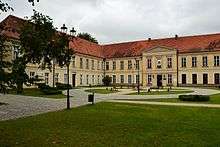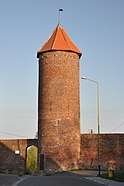Trzebiatów
Trzebiatów (pronounced Tshe-bia-toof [tʂɛˈbjatuf], German: Treptow an der Rega) is a town in the West Pomeranian Voivodeship, Poland, with 10,119 inhabitants (2016). Trzebiatów is located on the Rega River in the north-western part of Poland, roughly 9 kilometers south of the Baltic coast.
Trzebiatów | |
|---|---|
 Town Hall | |
 Coat of arms | |
 Trzebiatów | |
| Coordinates: 54°3′26″N 15°16′43″E | |
| Country | |
| Voivodeship | West Pomeranian |
| County | Gryfice |
| Gmina | Trzebiatów |
| Established | 9th century |
| City rights | 1277 |
| Government | |
| • Mayor | Zdzisław Matusewicz |
| Area | |
| • Total | 10.14 km2 (3.92 sq mi) |
| Population (2016) | |
| • Total | 10,119 |
| • Density | 1,000/km2 (2,600/sq mi) |
| Time zone | UTC+1 (CET) |
| • Summer (DST) | UTC+2 (CEST) |
| Postal code | 72-320 |
| Car plates | ZGY |
| Website | http://www.trzebiatow.pl |
Trzebiatów obtained town rights in 1277 under Pomeranian rulers and was initially settled by the Swedes. It was part of the Duchy of Pomerania.[1] In 1416 the town became part of the Hanseatic League,[1] then served as an important trade post and developed architecturally, with a typical Brick Gothic-style influence. It had trading connections with larger Hanseatic cities such as Gdańsk, Lübeck and Hamburg. During World War II the town escaped destruction and its preserved Old Town was registered as a protected historical monument of Poland.[1]
History
The lower Rega area around Gryfice and Trzebiatów was the site of a Slavic or Lechitic gród (fortified settlement) in the 9th century. The region was part of Poland during the reign of the first Polish rulers Mieszko I and Bolesław I the Brave. The first recorded mention of the town comes from 1170 when the Pomeranian duke Casimir I granted a few villages and oversight of a church in the town to settlers from Lund in Sweden. It was part of the Duchy of Pomerania, which separated itself from Poland as a result of the fragmentation of Poland.
In 1504, Johannes Bugenhagen moved to the town and became Rector of the local school.[2] On 13 December 1534 a diet was assembled in the town, where the Dukes Barnim XI and Philip I as well as the nobility officially introduced Lutheranism to Pomerania, against the vote of Erasmus von Manteuffel-Arnhausen, Prince-Bishop of Cammin. In the following month Bugenhagen drafted the new church order (Kirchenordnung), founding the Pomeranian Lutheran church (today's Pomeranian Evangelical Church).[3][4][5]
As a dowager, Sophia of Schleswig-Holstein-Sonderburg (1579–1658), widow of Philip II, Duke of Pomerania, lived in Treptow. Sophia's dower was a former nunnery, which she converted into a palace. While in Swedish service and thereafter Duke Francis Henry of Saxe-Lauenburg spent a lot of time with Duchess dowager Sophia in Treptow. Sophia's and Francis Henry's fathers were cousins. On 13 December 1637 Francis Henry and Marie Juliane of Nassau-Siegen (1612–1665) married in Treptow.[6] Their first child was born in Treptow in 1640.[7] Francis Henry also served Sophia as administrator of the estates pertaining to her dower.[7]
In 1637 Philip II died leaving the Pomeranian ducal house extinct. At this point the duchy came under Swedish occupation with the Brandenburgian electors claiming succession in Pomerania. It was not until 1648 that the electors annexed the central and eastern part of the former duchy, which formed the newly established province of Pomerania.

In 1750 the local palace was refurbished in classicist style for General Frederick Eugene of Württemberg, who resided there – with interruptions – until 1763. In the late 18th century, thanks to Polish noblewoman and writer Maria Wirtemberska née Czartoryska, the cultural life of the town was revived. She lived in the Trzebiatów Palace, and her early works and translations were created here. The Polish painter Jan Rustem visited her several times, and his paintings were part of the palace's art collection. The palace now houses a public library, founded in 1946 and named after Maria Wirtemberska née Czartoryska since 1999.
With the end of the Holy Roman Empire in 1806, Brandenburg-Pomerania, already since 1618 ruled in personal union with Ducal Prussia (Kingdom since 1701), also legally merged into Prussia and the different German confederacies and empires of which it formed part since.
Near the end of the World War II, in February 1945, despite the approaching front, the German authorities did not allow for the evacuation of the town's population. It was not until March 4 that the order to evacuate was issued, the day after the German army left the town, leaving the defenseless civilian population at the mercy of the approaching Soviet Army.[8] After the war the central and eastern part of Western Pomerania, including Trzebiatów, became part of Poland. The town's German population was expelled, and the town was resettled with Poles, many of whom were themselves expelled from pre-war Eastern Poland, annexed by the Soviet Union.
Since 1 January 1999, the town has been within West Pomerania Voivodeship, upon its formation from the former Szczecin and Koszalin voivodeships.
Culture
.jpg)
Trzebiatów's Day of the Buckwheat is a celebration during the first week of August. It is held in memory of the day when the town guard mistakenly dropped a hot bowl of buckwheat meal on invaders from the nearby town of Gryfice, alarming the whole town and ultimately saving it. Inhabitants of Trzebiatów celebrate that event with dances, concerts, competitions and by eating cereal with ham and bacon.
Notable People
- Johannes Aepinus (1499–1553), theologian and reformer
- Johannes Bugenhagen (1505–1521), Pomeranian reformer, rector at Treptow city school
- Maria Wirtemberska (1768–1864), Polish noblewoman, writer and translator
- Johann Gustav Droysen (1808–1884) a German historian
- Ferdinand von Arnim (1814–1866) a German architect and watercolour-painter
- Gustav Queck (1822–1897) a German educator and classical philologist
- Marcus Kalisch (1828–1885), Jewish scholar, a pioneer in the critical study of the Old Testament [9]
- Siegfried Sudhaus (1863–1914), German classical philologist
- Adam Bodnar (born 1977), lawyer, Polish Ombudsman
- Bartosz Ława (born 1979), Polish footballer, over 300 pro games
Nobility
- Frederick I of Württemberg (1754–1816), King of Württemberg
- Duke Louis of Württemberg (1756–1817) second son of Friedrich II Eugen, Duke of Württemberg
- Duke Ferdinand Frederick Augustus of Württemberg (1763-1834) the fifth son of Frederick II Eugene, Duke of Württemberg
- Duchess Frederica of Württemberg (1765–1785) daughter of Frederick II Eugene, Duke of Württemberg
- Duchess Elisabeth of Württemberg (1767–1790) Archduchess of Austria by marriage to Archduke Francis of Austria.
Twin towns - sister cities
Trzebiatów is twinned with:





References
- "Trzebiatów". ujscieregi.pl. Retrieved 2 September 2018.
- Hamburgische Biografie: Personenlexikon: 5 vols. (so far), Franklin Kopitzsch and Dirk Brietzke (eds.), Hamburg: Christians, 2001–2003 (vols 1–2), Göttingen: Wallstein, 2006– (to be continued), vol. 2 (2003), p. 79. ISBN 3-7672-1366-4.
- Pommern (11999), revised, and updated ed., Werner Buchholz (ed.), Berlin: Siedler, 22002, (=Deutsche Geschichte im Osten Europas), pp. 205-220. ISBN 3-88680-780-0.
- Theologische Realenzyklopädie: 36 vols., Gerhard Müller, Horst Balz and Gerhard Krause (eds.), Berlin et al.: de Gruyter, 1977–2007, vol. 27 (1997): 'Politik, Politologie - Publizistik, Presse', pp. 43ff. ISBN 3-11-015435-8.
- Richard Du Moulin Eckart, Geschichte der deutschen Universitäten (11929), reprint: Hildesheim and New York: Olms, 21976, pp. 111f. ISBN 3-487-06078-7.
- N.N., "VII. Sophie von Schleswig-Holstein, Witwe Herzog Philipps II. von Pommern, auf dem Schlosse in Treptow an der Rega", in: Baltische Studien (1832 to date), vol. 1, Gesellschaft für Pommersche Geschichte und Alterthumskunde and Historische Kommission für Pommern (eds.), vol. 1: Stettin: Friedrich Heinrich Morin, 1832, pp. 247–259, here pp. 250 and 257.
- N.N., "VII. Sophie von Schleswig-Holstein, Witwe Herzog Philipps II. von Pommern, auf dem Schlosse in Treptow an der Rega", in: Baltische Studien (1832 to date), vol. 1, Gesellschaft für Pommersche Geschichte und Alterthumskunde and Historische Kommission für Pommern (eds.), vol. 1: Stettin: Friedrich Heinrich Morin, 1832, pp. 247–259, here p. 257.
- Trzebiatów: przewodnik historyczny, Kubacki, p. 8.
- . Encyclopædia Britannica. 15 (11th ed.). 1911.
| Wikimedia Commons has media related to Trzebiatów. |



.jpg)